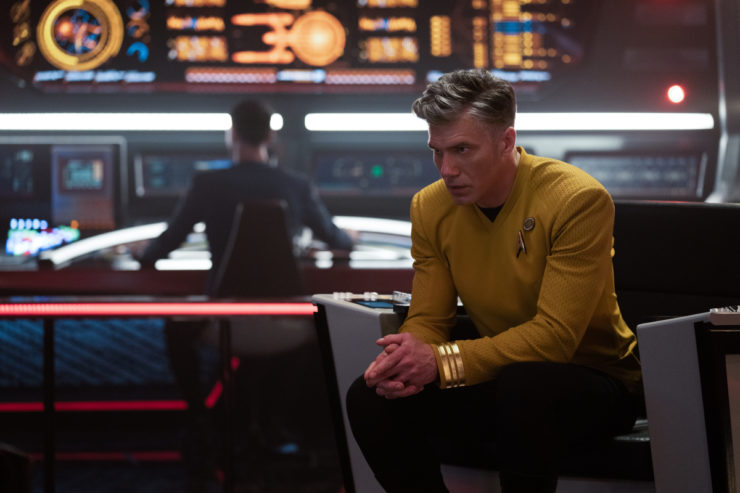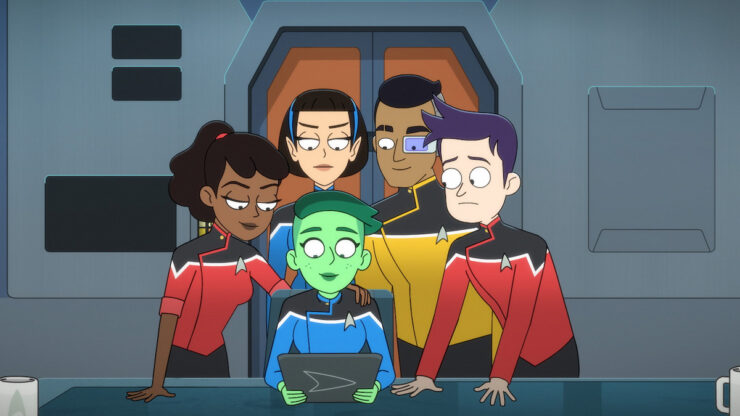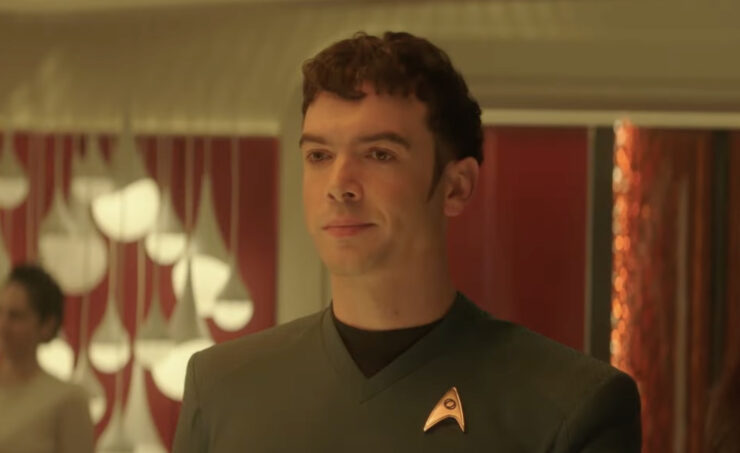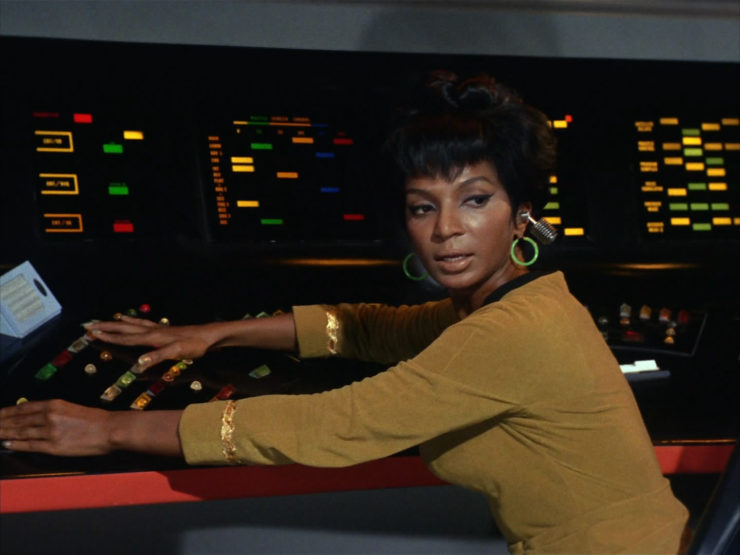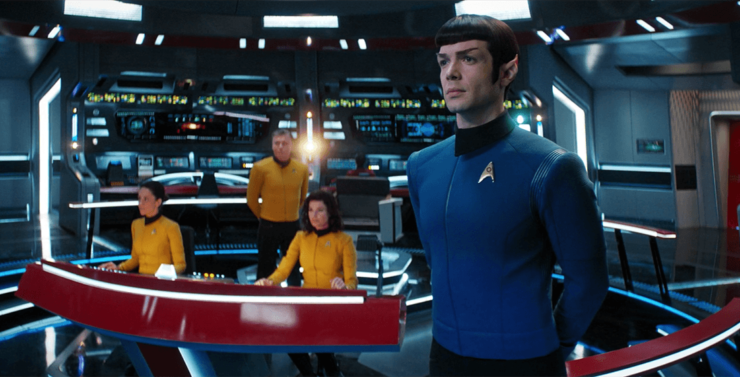The Gorn were introduced in the original series’ “Arena,” and while they’ve been seen briefly here and there since then—in the animated series’ “The Time Trap,” Lower Decks’ “Veritas” (GORN WEDDING!) and “An Embarrassment of Dooplers,” and Enterprise’s “In a Mirror, Darkly, Part II”—there’s been very little done with them of any depth (outside the tie-in fiction, anyhow).
Using the Gorn on Strange New Worlds was always going to be fraught because the implication in “Arena” was that this was first contact with the Gorn. Yet part of La’an’s backstory on SNW is that she was the sole survivor of a Gorn attack. We get the details of that this week in a thrill-ride of an episode that is one of the best space-battle episodes of Trek you’re ever likely to see.
One of the difficulties in doing a prequel is knowing that the viewers are aware of things that were revealed in the stuff that aired previously but takes place later. Which means that the viewers and the writers know more than the characters do.
Which makes it very tempting to do things like use characters before they were supposed to first appear, like having Starfleet encounter cloaking devices and tribbles and Ferengi before they were “first” seen on previously aired series taking place later.
Sadly, the use of the Gorn in SNW doesn’t entirely work with what we saw in “Arena,” neither “factually” in terms of what was said in the episode and also philosophically in terms of what “Arena” was about.
The plot of “Memento Mori”—a Latin phrase that practically every TV show has used as an episode title at some point or other, and the fact that Trek never used it until this week is something of a small miracle—has the Enterprise going to resupply a colony only to find it almost entirely wiped out. There are no bodies, just a lot of blood indicating that bodies were dragged to a single place before being removed.
The only survivors were on a cargo ship. In the midst of their being evacuated to the Enterprise for medical treatment, a ship comes out of nowhere and attacks, killing three more colonists and six of the Enterprise crew.
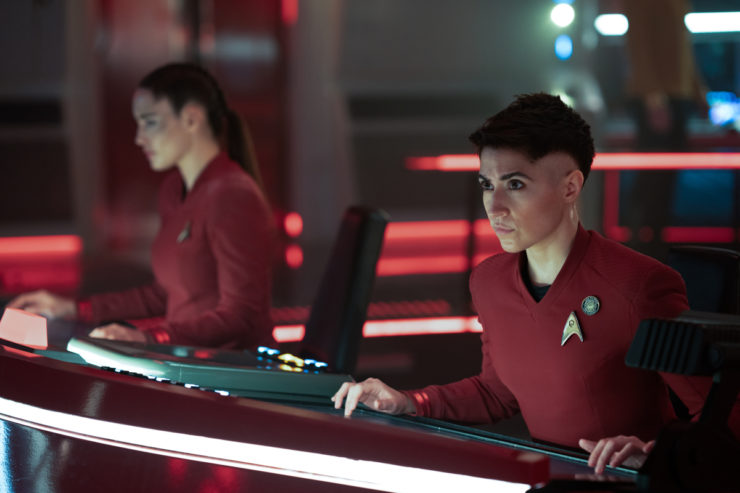
What follows is an impressive game of cat-and mouse through a brown dwarf. The Enterprise is badly damaged, and the crew must rely on their wits and cleverness to get out of it. This episode is right up there with the original series’ “Balance of Terror” and “The Doomsday Machine,” TNG’s “Power Play,” DS9’s “Civil Defense” and “Starship Down,” Voyager’s “Year of Hell” two-parter, Discovery’s “There is a Tide,” Prodigy’s “Time Amok,” and Lower Decks’ “First First Contact” for impressive action sequences that are great fun to watch, involving the characters being clever and thinking their way through problems as much as they are fighting.
While this is pretty much La’an’s episode in the same way that the previous episodes have been Pike’s, Uhura’s, and Number One’s, the real star of this one is Anson Mount. Throughout this entire crisis, Pike is constantly thinking, constantly trying to figure out a way to turn their disadvantages into advantages. There are echoes of the best of previous Trek captains here: a willingness to do something batshit crazy to get the job done (Kirk, Archer, Burnham, Dal), always thinking three steps ahead (Picard, Saru), and an easy and almost effortless confidence in his crew (Sisko, Janeway, Freeman).
La’an’s traumatic past, mentioned several times previously, is spelled out—and, in the end, she herself remembers all of it for the first time after a mind-meld with Spock. (More on that in a bit.) When she was much younger, she was on a colony ship, the S.S. Puget Sound, when it was attacked by the Gorn. She was the only survivor of the ensuing massacre. Among the dead was her brother, whom she regularly sees hallucinations of all episode. Eventually, with Spock’s telepathic help, she’s able to retrieve her full memories, including the Gorn’s odd method of communicating via light. Her brother doped their language out, and they’re able to use it against them, by convincing one Gorn ship that the other had been taken over by humans, thus leading to the former ship destroying the latter.
Prior to that, Pike—having been told by La’an that the Gorn are relentless in their pursuit—lures their ship deep into the brown dwarf, where the pressure crushes the Gorn ship like an egg.
Enterprise only fares a little bit better, and one more crew member is killed when the lower decks have to be sealed off before they become uninhabitable. Said crew member is injured, and Kyle is trying to help him, but the injured crew member throws Kyle toward the door so at least one of them will live.
That’s one of several examples of our heroes—and that word is important—making sacrifices to save others. Number One has been badly injured, and the last bit of plasma they have is needed to save her life. But when another crew member also needs it, Number One orders M’Benga to use it on the other person instead. Both La’an and Spock volunteer for a dangerous shuttle mission because it will help the Enterprise get out of their predicament.
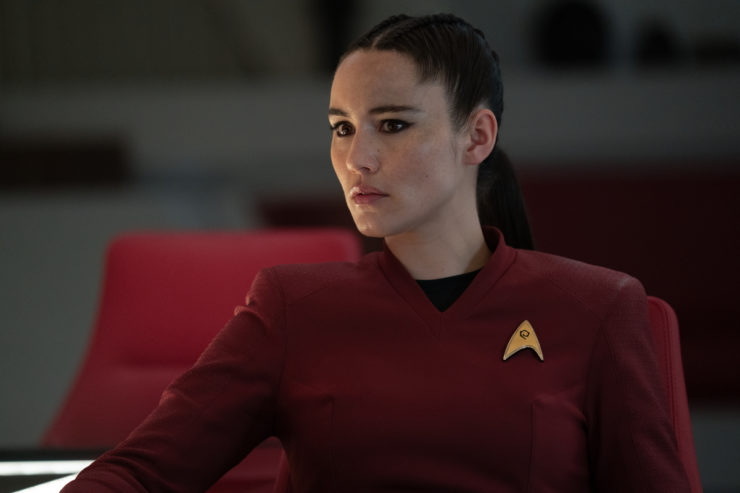
At the top of the episode, we’re told that it’s Remembrance Day: a day when Starfleet personnel remember the sacrifices of those who died in the line of duty. Everyone wears a pin representing a ship where they lost someone. Disappointingly, we don’t know what most of the pins are, aside from La’an’s—hers is the Puget Sound. (I’m guessing the one Uhura’s wearing is the ship her grandmother served on.) Given Trek’s rather irritating tendency toward casually killing off guest stars and extras with no fanfare and barely any notice, I approve of any plot point that makes note of their sacrifices.
The Starfleet people’s willingness to sacrifice their lives to save other people is in direct contrast to the Gorn, who sacrifice themselves several times, not to save others, but to ensure a greater victory. It’s one of several ways that the notion of the Gorn as monsters is reinforced.
And this is, as I said, problematic on two different levels. For starters, Kirk’s crew spoke of the Gorn as if they were unknown. One could, theoretically, interpret Kirk’s words to fit with the notion here that the Gorn are mysterious boogeymen who have raided on the outskirts of Federation territory, but whom nobody (aside from La’an) has lived to see, but it’s a rough interpretation. And La’an at one point describes the Gorn using language similar to what Kirk used in the original series episode, about how humans have an instinctive revulsion for reptilian lifeforms.
Still, there was no need for this to be the Gorn, no need to create the discontinuity, especially because of the other, more philosophical problem: the entire point of “Arena” is that the Gorn and the Federation could, theoretically, find common ground if they just talked to each other instead of fighting and making assumptions about the other (the Gorn’s assumption that the Federation invaded, the Federation’s assumption that the Gorn attack was unprovoked). “Memento Mori” posits that the Gorn are pure evil, nasty bastards who trick and massacre humans (some of which we also saw in “Arena,” it’s true), but without the hopeful message that “Arena” had in the end. Of course, that’s partly because “Arena” hasn’t happened yet…
This would’ve worked better if it was, say, the Tzenkethi. That’s another enemy to the Federation, one established in DS9’s “The Adversary,” and about whom we know, basically, bupkuss. If you searched for “Gorn” and replaced it with “Tzenkethi” in the script, it wouldn’t change a thing, and it would’ve been a long-overdue fleshing out of a species that actually was crying out for it. Best of all, it wouldn’t have created a discontinuity that gives a segment of the fanbase yet another excuse to slag the Secret Hideout shows and use it for their YouTube videos and Facebook posts complaining about how they’ve “broken canon” by violating the dialogue of the original series. (Because, of course, Star Trek has always been a model of consistency, as Captain James R. Kirk of the Earth ship Enterprise, which was sent into space by the United Earth Space Probe Agency, can tell you. As can his Vulcanian science officer, not to mention the Bajora, the planet Kling, and the bumpy-headed Trill whose hosts have no personalities.)
By the way, there’s another discontinuity here, but it’s a minor one. When the concept of the Vulcan mind-meld was introduced in “Dagger of the Mind” on the original series, Spock said he’d never done the technique with a human before. That line was bound to be ignored the minute Spock became a character on Discovery, and sure enough, he melds with La’an here. Honestly, I’m completely okay with it—to deny themselves so important a part of Vulcan society as the mind-meld in a show starring Spock because of one line of dialogue in one episode is ridiculous. It also strains credulity that Spock never engaged in a mind-meld with a human in his decade-and-a-half of Starfleet service prior to the first season of the original series anyhow…
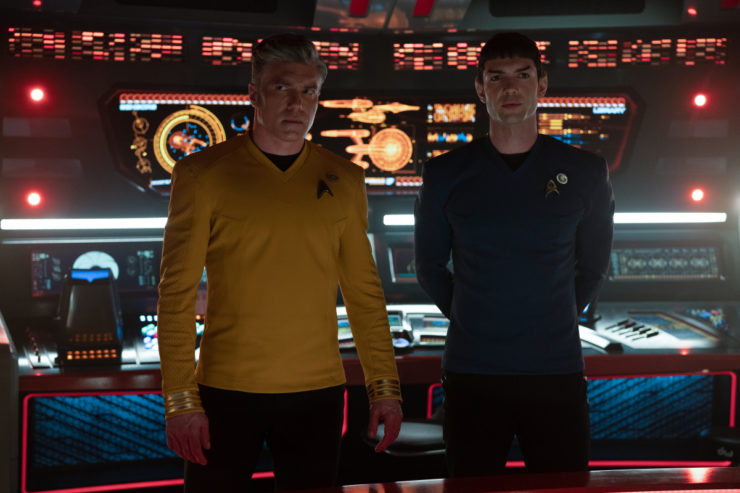
The episode has some other problems. While I like Number One’s stoicism (after she collapses in sickbay with major thoracic damage, M’Benga says to her, “You said you were fine,” and she blithely replies, “I was mistaken”) and her giving away the plasma she needs to another crew member, it’s the second time in four weeks she’s been sidelined. Hemmer and Uhura wind up trapped in a cargo bay with a large piece of equipment, and they have to work to keep the ship in one piece, made difficult by Hemmer having broken hands. Uhura has to follow his very explicit instructions to keep the ship from blowing up. Of course, they’re trapped there because the Gorn’s battle damage specifically hit sickbay and the cargo bay—the two places besides the bridge occupied by members of the opening credits. It’s a cheap writer’s trick, mostly there to add to the tension in sickbay and to give Bruce Horak and Celia Rose Gooding something to do.
As always, the visuals are spectacular. The design of the Gorn ships is fantastic, and the ships’ twirling about through space is beautifully realized. The turbulence of the brown dwarf looks superb. But the best is the way director Dan Liu films the Enterprise bridge after the initial battle: there’s a miasma choking the air on the bridge, making everything seem just a bit more desperate. It’s aided by sweat on most of the characters (a consequence of being in the brown dwarf), adding to the tension. (Liu made his bones as an editor and director in the Walking Dead franchise.)
And the writing continues to be very strong, from Spock’s pedantic and complex answers, and his rhetorical rejoinders, to Pike’s calmly taking the most crazy interpretation of the possibilities to heart as plans rather than cautions, to Ortegas’ smartass commentary on the proceedings. Plus we get some snarky banter between Number One and Chapel, which will never not be hilarious. (The script is credited to co-executive producer Davy Perez and supervising producer Beau DeMayo.)
I just wish they’d used someone other than the Gorn. It would’ve been just as strong an episode…
Keith R.A. DeCandido will be a guest at Fanboy Expo Columbus this coming weekend at the Greater Columbus Convention Center. He’ll be appearing at the Bard’s Tower booth on the exhibit floor, along with fellow word-slingers Brian Anderson, Rick Heinz, Gama Martinez, and Dan Wells, and Trek actor/voiceover artist Carlos Ferro.










